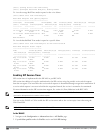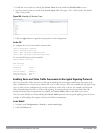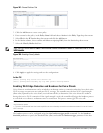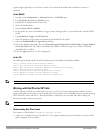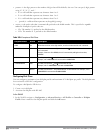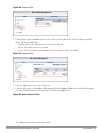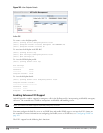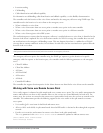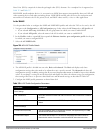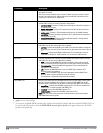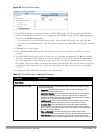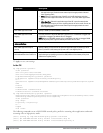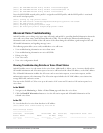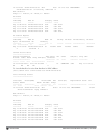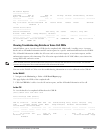
715 | VoiceandVideo DellPowerConnectW-SeriesArubaOS6.2 | User Guide
----------------------
AP Name BSSID ESSID Client(MAC) Client(IP) Client Name Server(IP)
Registration State Call Status ALG Flags
------- ----- ----- ----------- ---------- ----------- ---------- -
----------------- ------------ --- -----
moscato 00:0b:11:5c:d6:80 home 00:00:5c:04:b3:10 10.20.1.100 Client
10.13.8.1 REGISTERED Idle h323 R
Num Clients:1
Flags: R - Remote user
Understanding Battery Boost
Battery boost is an optional feature that can be enabled for any SSIDs that support voice traffic. This feature
converts all broadcast and multicast traffic to unicast before delivery to the client. Enabling battery boost on an
SSID allows you to set the DTIM interval from 10 - 100 (the previous allowed values were 1 or 2), equating to 1,000
- 10,000 milliseconds. This longer interval keeps associated wireless clients from activating their radios for multicast
indication and delivery, leaving them in power-save mode longer, and thus lengthening battery life. The DTIM
configuration is performed on the WLAN, so no configuration is necessary on the client.
An associated parameter available on some clients is the Listening Interval (LI). This defines the interval (in number
of beacons) after which the client must wake to read the Traffic Indication Map (TIM). The TIM indicates whether
there is buffered unicast traffic for each sleeping client. With battery boost enabled, the DTIM is increased but
multicast traffic is buffered and delivered as unicast. Increasing the LI can further increase battery life, but can also
decrease client responsiveness.
NOTE: Do not enable battery boost if your network includes Polycom SpectraLink devices that use the Push-to-Talk feature.
You can use the WebUI or CLI to enable the battery boost feature and set the DTIM interval in the SSID profile.
In the WebUI
1. Navigate to the Configuration > AP Configuration page. Select either the AP Group tab or AP Specific tab.
n If you selected AP Group, click Edit by the AP group name for which you want to enable battery boost.
n If you selected AP Specific, select the name of the AP for which you want to enable battery boost.
2. Under Profiles, expand Wireless LAN, then select Virtual AP. In the Virtual AP list, select the appropriate virtual
AP instance.
3. In the Profile Details section, select the SSID profile you want to configure.
4. Click the Advanced tab.
5. Scroll down the Advanced options and select the Battery Boost check box.
6. Scroll up to change the DTIM Interval to a longer interval time.
7. Click Apply.
In the CLI
wlan ssid-profile <profile>
battery-boost
dtim-period <milliseconds>
Enabling LLDP
Link Layer Discovery Protocol (LLDP), is a Layer-2 protocol that allows network devices to advertise their identity
and capabilities on a LAN. Wired interfaces on Dell APs support LLDP by periodically transmitting LLDP Protocol



